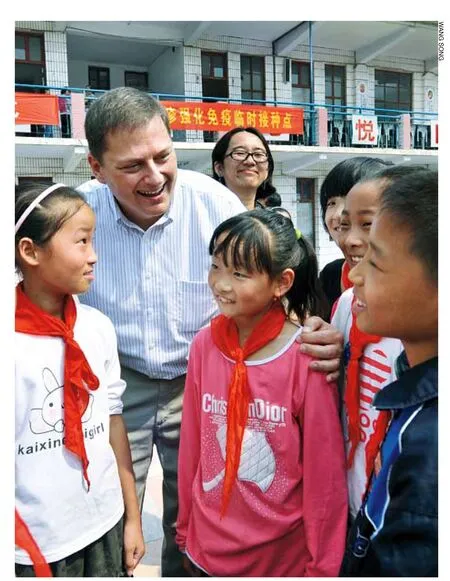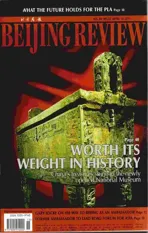Curing The World
2011-10-14ByYINPUMIN
By YIN PUMIN
Curing The World
By YIN PUMIN
The WHO approves China’s vaccine regulation system
The World Health Organization(WHO) said China had complied with international standards for the regulation of vaccines after it completed the assessment procedures at the end of 2010.
China’s national regulatory authorities, represented by the State Food and Drug Administration (SFDA), in the area of vaccines were recognized by WHO as functional, Lahouari Belgharbi, a scientist from the WHO Department of Immunization,Vaccines and Biologicals, told a conference in Beijing on March 1.
“Chinese manufacturers can now submit applications to have their vaccine prequali fi ed by the WHO,” he said.
Meanwhile, the WHO released a statement on its website, saying that this could eventually open the door for vaccines produced in China to be supplied through UN agencies to developing countries.
A significant step
In December last year, Belgharbi headed a group of WHO experts to conduct the latest assessment, examining the performance of SFDA with regard to vaccine regulation. It followed unsuccessful attempts by China to pass the WHO vaccine regulatory system assessment in 1999, 2001 and 2005.
The WHO experts specifically looked at seven fi elds of China’s vaccine regulation system, including the overall regulatory framework, marketing authorization and licensing,post-marketing surveillance, especially the adverse reactions to immunization, lot release by the national regulatory authority, laboratory access, regulatory inspections of manufacturing sites and distribution channels, and authorization and monitoring of clinical trials.
They visited institutes involved in vaccine regulation in Beijing, Shanghai and Hebei and Jiangsu provinces.
The expert panel finally concluded that China’s national regulatory authorities reached WHO’s requirement. China became the 36th vaccine-producing country to have its regulatory system approved by the WHO.
The conclusion is the culmination of 19 months of intensive effort by the SFDA to implement a roadmap, developed by Chinese experts, with continuous advice from the WHO, to strengthen capacity for regulation of vaccines, the WHO statement says.
“Getting WHO approval this time shows our improved vaccine regulation efforts and guaranteed vaccine quality,” said Shao Mingli, Commissioner of the SFDA.
“It is a validation of the capability of the Chinese regulatory authority,” said WHO China Representative Michael O’Leary. With a regulatory system for vaccines documented to comply with international standards, vaccine manufacturers in China are now eligible to apply to the WHO for pre-quali fi cation of vaccines.
WHO pre-qualification, which is a guarantee that a specific vaccine meets international standards of quality, safety and ef fi cacy, is a prerequisite for manufacturers to supply to countries through UN procuring agencies, says the WHO statement. WHO independently evaluates each application for pre-quali fi cation of a speci fi c product.
It is expected specific vaccines from China could be approved in one to two years,according to the statement.
Vaccines are produced in only a small number of countries and often exported from the country of manufacture to many countries.Hence the eventual ability of UN procuring agencies to source vaccines from Chinese manufacturers is expected to have a significant, bene fi cial impact on the global supply of vaccines of assured quality, the statement says.
“China produces a large number of vaccines at affordable prices and could make a significant contribution to meeting the world’s vaccine needs,” said O’Leary.
According to SFDA statistics, China has 36 vaccine-producing plants manufacturing 49 kinds of vaccine for 27 different diseases. It has an annual capacity of nearly 1 billion doses.
“It is a chance for China to make a much more signi fi cant contribution to global world vaccine needs,” Shao said.
Liu Peicheng, Director of the Media Relations at Sinovac Biotech Ltd., a Beijingbased biopharmaceutical company, believes the WHO’s recognition will give a strong boost to China’s vaccine producers.
“The approval will help raise people’s confidence in China-made vaccines, which are, as the WHO recognizes, up to international standards,” Liu told Xinhua News Agency.

With a regulatory system for vaccines documented to comply with international standards, vaccine manufacturers in China are now eligible to apply to the WHO for pre-qualification of vaccines
He said it would help Chinese vaccine producers tap into the international market.

CARING ABOUT HEALTH: An official from the World Health Organization visits a primary school in Kaifeng County, Henan Province, on September 11, 2010, to investigate students’ conditions, after receiving measles vaccines
However, Gu Weijun, Secretary General of the China Pharmaceutical Association of Plant Engineering, said it will be a long time before Chinese vaccines enter the international market, due to weak management of vaccine manufacturers.
“It still needs four to fi ve years for Chinese vaccines to make preparations,” Gu told Beijing-basedCentury Weeklymagazine.
Breaking the bottleneck
Also on March 1, a new Goods Manufacturing Practice (GMP) code adopted by the SFDA took effect. In line with international standards, the new code put in place stricter requirements for vaccine production to ensure production of vaccines of assured quality.
Meanwhile, the WHO held a training session on March 1 for Chinese vaccine manufacturers about pre-quali fi cation reporting procedures.
Facing WHO’s high standards and strict requirements, many Chinese manufacturers expressed their worries.
“Under the current situation, I’m afraid few vaccine producers in China can meet WHO’s requirements,” an executive with a private vaccine company from Ningbo, east China’s Zhejiang Province, toldCentury Weekly.
Liu with Sinovac Biotech Ltd. said such worries highlighted Chinese vaccine producers’ poor technology and the quality problem of Chinese vaccines.
For a long time, Chinese vaccines have been criticized for faults in the links of production, circulation, utility and supervision.
In December 2009, a total of 215,800 units of rabies vaccines made by Jiangsu Ealong Biotech Co. and Hebei Bioforwell Co. from July to October 2008 were found with quality problems. Then the two companies’ production licenses were revoked. They were also fi ned a combined total of more than 30 million yuan ($4.57 million).
In March last year, Beijing-basedChina Economic Timessaid improperly stored vaccines in north China’s Shanxi Province killed several children and sickened dozens of others who were vaccinated between 2006 and 2008.
“Chinese vaccine producers must put more effort in quality supervision to ensure Chinese vaccines go around the world,” said Liu.
Another challenge is Chinese vaccine producers still lagged behind large foreign counterparts in terms of technology, Liu said.
According to Wang Jing, Marketing Manager of Tianjin Tasly Jinna Biotech Co.Ltd., most Chinese vaccines are imitations of foreign products and some new vaccines,such as pneumococcal vaccine and rotavirus vaccine, are still in the laboratory stage.
“Regarding the introduction of foreign technologies, foreign vaccine producers are only willing to put the bottling lines in China,” Wang said.
Besides, there exist problems of decentralized investment and redundant development in Chinese vaccine industry, according to Wang.
Hence, he suggests strengthening cell and virus cultivating technology and biological puri fi cation technology.
In recent years, Chinese food and drug authorities and vaccine producers have realized the problems and started to strengthen the industry’s mass production and technology integration.
In July 2009, the National Vaccine and Serum Institute and the National Institute for the Control of Pharmaceutical and Biological Products launched a research center for newtype vaccines in Beijing.
In November 2010, the National Engineering Research Center for the Combined Vaccine was approved by the SFDA.
In its 2010 research plan, the Changchun Institute of Biological Products of the China National Biotech Group said it would focus on mass producing freeze-dried Hepatitis A live vaccines, bioreactors’ mass cultivations,producing technologies of freeze-dried rabies vaccines and inactivated Hepatitis A vaccines.
“With these efforts, China may take a place on the international market in the near future,” Wang said.
According to Liu, Beijing Sinovac Biotech Ltd. has worked out a “going global”strategy and is preparing to go through the WHO’s pre-quali fi cation process.
“We have the confidence to get the WHO’s pre-qualification for our influenza vaccine within 2013,” Liu said.
